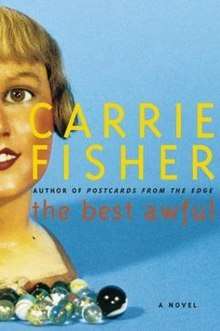The Best Awful There Is
The Best Awful There Is (retitled The Best Awful as a paperback), is a 2004 novel by actress and author Carrie Fisher published in 2004.[1] It is a sequel to her debut novel Postcards from the Edge.[2]
 Cover to "The Best Awful" renamed edition | |
| Author | Carrie Fisher |
|---|---|
| Country | United States |
| Language | English |
| Genre | Autobiographical novel |
| Publisher | Simon & Schuster |
Publication date | January 2004 |
| Media type | Print (hardback and paperback) |
| Pages | 269 (hardback edition) & 288 (paperback edition) |
| ISBN | 0-684-80913-3 (hardback edition) & ISBN 0-7432-6930-6 (paperback edition) |
| OCLC | 51086674 |
| 813/.54 21 | |
| LC Class | PS3556.I8115 B4 2003 |
| Preceded by | Postcards from the Edge |
Like most of Fisher's books, this novel is semi-autobiographical and fictionalizes events from her real life.[3] The book features the protagonist character Suzanne Vale that first appeared in Postcards from the Edge.[4] The book fictionalizes the author's relationship with Bryan Lourd, the father of her daughter Billie Lourd.[5]
The Best Awful There Is was later published with the shorter title The Best Awful and is now largely known by this title.
Plot summary
It is about Suzanne Vale, an actress with bipolar disorder who married Leland Franklin, a studio executive who helped her find her "far-flung best self." He then left her, for a man, when their daughter, Honey, was three.
Now, three years later, Vale is a successful TV talk show host with a six-year-old daughter, a gay ex-husband, and an aging starlet mother. It is her love for Honey that keeps her going.
When Vale, a recovering drug addict, stops taking her medication, she is plunged into a manic episode. She goes on a search for OxyContin in Tijuana with a tattoo artist friend and new house guest, a clinically depressed patient she met at her psycho-pharmacologist's office.
A psychotic break lands Vale at Shady Lanes, where she is the "latest loony to hit the bin." Despite her mental illness, Vale still has her wit and ability to find irony in every situation as she struggles back from the brink of insanity.
"You entered the hospital broken, found some other like broken patient people, and once in their company, looked down on the other more pathetic inhabitants of the bin you shared, those flying even lower than you and your lo-flung co-conspirators."
Pharmacological facts and scenes from group therapy are revealed. Rather than hide the truths of mental disorders, the humor serves to highlight them.
A happy ending is contrived for Vale and Honey, a sweet little girl, but a little happiness in the midst of all the craziness is a good thing.
Characters
- Suzanne Vale – young actress, the main protagonist
- Leland Franklin – movie director and Vale's husband
- Honey – their daughter
References
- Fisher, Carrie (January 5, 2005). The Best Awful: A Novel (Reprint ed.). Simon & Schuster. ISBN 9780743269308.
- "Carrie Fisher's On 'Best Awful'". cbsnews.com. Retrieved September 16, 2017.
- "The Best Awful by Carrie Fisher". The Independent. February 22, 2004. Retrieved September 16, 2017.
The Best Awful is more obviously autobiographical than Postcards and, perhaps as a result, not as laugh-out-loud funny.
- Cooke, Rachel (February 8, 2004). "Observer review: The Best Awful by Carrie Fisher". The Observer. ISSN 0029-7712. Retrieved September 16, 2017.
- Weinraub, Bernard (February 11, 2004). "For Hollywood Misery, An Alter Ego Helps". The New York Times. ISSN 0362-4331. Retrieved September 16, 2017.
In her novel, and in the interview, Ms. Fisher says her relationship with her 11-year-old daughter, Billie (named Honey in the book), forced her to take control of her life. Ms. Fisher and her former husband, Bryan Lourd, a partner at the Creative Artists Agency, are jointly rearing the child, and the book is dedicated to them.